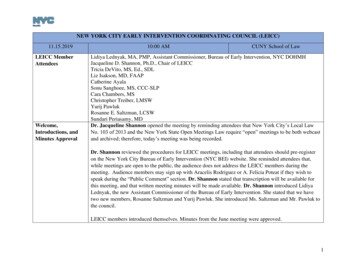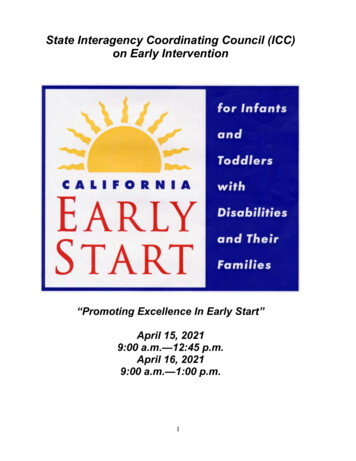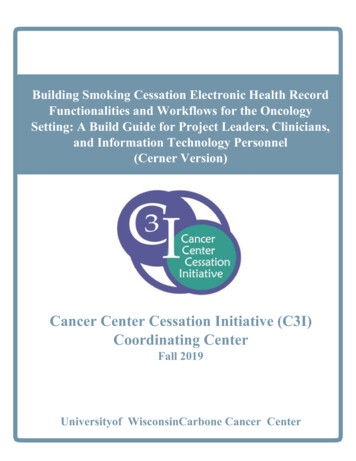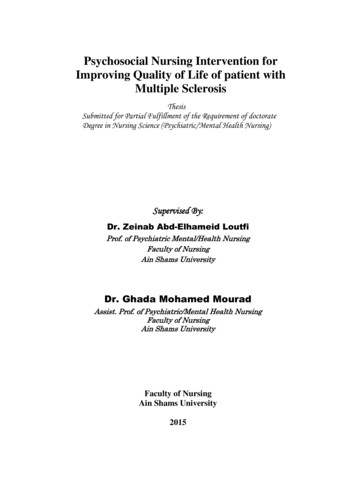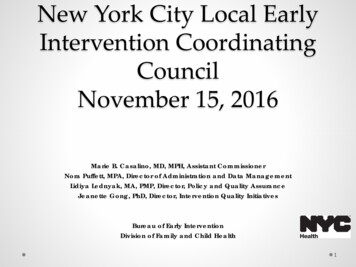
Transcription
New York City Local EarlyIntervention CoordinatingCouncilNovember 15, 2016Marie B. Casalino, MD, MPH, Assistant CommissionerNora Puffett, MPA, Director of Administration and Data ManagementLidiya Lednyak, MA, PMP, Director, Policy and Quality AssuranceJeanette Gong, PhD, Director, Intervention Quality InitiativesBureau of Early InterventionDivision of Family and Child Health1
NEW YORK CITY EARLY INTERVENTION COORDINATING COUNCIL (LEICC)MEETING OF NOVEMBER 15, 2016AGENDA ITEMSMEETING CONVENED10:11 AM.INTRODUCTIONSDISCUSSIONThe following members were present:Marie B. Casalino, Assistant Commissioner, Bureau of Early Intervention, NYC DOHMHTracey LeBright, Chair of LEICCNicole BrownKelvin ChanCindy Lin ChauAgatha GuadagnoKathleen HoskinsElizabeth IsaksonLois KesslerRosalba MaistoruDawn OakleyKaren SametJacqueline ShannonLinda SilverCynthia WinogradI.Tracey LeBright, Local Early Intervention Coordinating Council (LEICC) Chair1. Review of procedures for LEICC meetings:a. Attendees should pre-register on the New York City Bureau of Early Intervention (NYC BEI) website for LEICCmeetings.b. Meetings are open to the public, but the audience does not address the LEICC members during the meeting.c. Audience members may sign up with Nannette Blaize or Felicia Poteat to speak during the “Public Comment”section.d. As of May 15, 2014, New York City’s Local Law No. 103 of 2013 and the New York State Open Meetings Lawrequire “open” meetings to be both webcast and archived. This meeting is being recorded today.e. Transcription is available for this meeting. Written meeting minutes will still be made available2. Minutes from last meeting were reviewed and approved with correction to Public Comment. The federal overtimeprovisions are contained in the Fair Labor Standards Act (FLSA). Unless exempt, employees covered by the Actmust receive overtime pay for hours worked over 40 in a workweek at a rate not less than time and one-half theirregular rates of pay. Key provisions of the final rule include updating the salary and compensation levels needed1LEICC MTG OF 11.15.16
NEW YORK CITY EARLY INTERVENTION COORDINATING COUNCIL (LEICC)MEETING OF NOVEMBER 15, 2016for Executive, Administrative and Professional workers to be exempt. Specifically, the Final Rule sets the standardsalary level at the 40th percentile of earnings of full-time salaried workers in the lowest-wage Census Region,currently the South ( 913. per week; 47,476. annually for a full-year worker)BUREAU UPDATESII. Dr. Marie B. Casalino, Assistant Commissioner1. General Announcements:a. Early Intervention services will continue as usual, and have not changed as a result of the recent presidentialelection. Our mission has not changed. Early Intervention (EI) will continue to provide services to eligiblechildren and their families regardless of race, ethnicity, religion, or immigration status.b. Dr. Jeanne Clancy, former Director of Queens Regional Office and Director of the Families as Partners Project,passed away on 11/14/16.2. Bureau Transition Announcements:a. The Acting Director of Early Intervention Services is Agatha Guadagno, Director of the Queens Regional Officeb. Re-organization of Bureau Administrative Units: Developmental Monitoring Unit will report to Lidiya Lednyak NYEIS Administration (including Help Desk and Transportation) will report to Nora PuffettSEICC REPORT3. New York State Early Intervention Coordinating Council (SEICC) 9/15/2016a. Revisions to Bylaws regarding Quorum and Majority Voting Current membership 27 members There must be 14 members present for a vote. An SEICC Bylaws change would align with current statute. Since there were fewer than 14 members present at the SEICC, there was no vote on the quorum. Voting is postponed and will be discussed at the next SEICC meeting.b. Social-Emotional Task Force Update Mary McHugh, New York State (NYS) Office of Mental Health, is the Task Force Chair Bob Frawley was the editor From September’s meeting there was a focus on: Ongoing work to finalize document Discussion of next steps Any additions necessary? Is information useful for caregivers and families?2LEICC MTG OF 11.15.16
NEW YORK CITY EARLY INTERVENTION COORDINATING COUNCIL (LEICC)MEETING OF NOVEMBER 15, 2016 Does the document adequately describe the goals, objectives, and strategies?c. Update: Document [a Joint Task Force of the SEICC and NYS Early Childhood Advisory Council (ECAC) document]was being advanced to the ECAC but there could not be a vote because there was no quorum. There was adecision to pass it on to the ECACd. State Department of Health (SDOH) Activities Change to Service Coordination rate methodology awaiting State Plan Amendment (SPA) approval No update on the Executive Budget proposalse. Health Home Model to Serve Children Projected enrollment date for EI continues to be March 2017 Discussion about webinars presented by State to The New York State Association of Counties (NYSAC)f.Maternal Child Health (MCH) Block Grant State Plan Presentation by Lauren Tobias, Director, Division of Family Health Title V Block Grant funding based on evidence-based strategies to achieve health outcomes. This grant aimsto improve the health and well-being of women (particularly mothers) and children. Framework for the work of the Division of Family and Child Healtho MCH Essential Serviceso Reduce maternal morbidity/mortalityo Reduce infant morbidity/mortalityo Early Interventiono School Health Programo Adolescent Healtho Support oral health and preventive serviceso Children with Special Health Care Needso Home visitingo Health equityg. Early Intervention Program (EIP) Proposed Regulations Will be published for public comment3LEICC MTG OF 11.15.16
NEW YORK CITY EARLY INTERVENTION COORDINATING COUNCIL (LEICC)MEETING OF NOVEMBER 15, 2016 CLINICIANS’ GUIDEAND ALGORITHMCDC SURVEILLANCEREPORTGoal: Adoption prior to 2017Areas covered:Evaluation and screening of child, and assessment of child and familyScreening and multidisciplinary evaluationIndividual Family Service Plan (IFSPs)Monitoring of service providersProcedural safeguardsThird-party paymentsProvider approvalConflict of InterestOffice for People With Developmental Disabilities (OPWDD) Notice4. NYC EI Clinicians’ Guide and Algorithm: 2016a. Rationale behind development of Algorithm and Guide: Tool for clinicians to use with any child 3 years presenting in primary care Clarify which children should be referred to the NYC EIP Define the importance of the pediatric provider’s roleb. Dissemination: Grand Rounds presentations, other provider group presentations Available in hardcopy and online:Website: int/ei-algorithm-guide.pdf Mailings1. Central Nervous System (CNS) Defects Surveillance Project 2016-2017 – Centers for Disease Control andPrevention (CDC) Funded Projecta. NYC has received funding to help conduct population-based surveillance of microcephaly and other adverseoutcomes (such as hydrocephalus, arthrogryposis, malformations of the corpus callosum) possibly linked tomaternal Zika infectionb. Participate in pooled CDC data projectsc. Ensure that obstetric and pediatric providers link affected infants to services (beyond EI)d. Population-based surveillance in collaboration with NYS Congenital Malformations Registry (CMR)e. Active case-finding, including use of electronic data systemsf. Outreach to health care and social service providers, as well as to communitiesg. Next Steps4LEICC MTG OF 11.15.16
NEW YORK CITY EARLY INTERVENTION COORDINATING COUNCIL (LEICC)MEETING OF NOVEMBER 15, 2016 LEICC DISCUSSIONDATA REPORTHire project staffExpand/develop databases and establish mechanisms for data collectionInitiate outreach to perinatal care centers, obstetric care providers, and the pediatric communityDevelop communications for health care providersLEICC Discussion:- Jacqueline Shannon asked if a pregnant mother with Zika was eligible for EI services. Dr. Casalino clarified that apregnant woman with Zika is not eligible for EI services because the EIP is for children with disabilities birth to three(3) years old. Therefore, if a Zika-affected woman gives birth to a child with birth defects that result in disability (e.g.,microcephaly), then the child would be eligible for EI services.III. Nora Puffett, Director of Administration and Data Management1. Current dataa. NYC EIP is a little more than half way through the year, and data is showing the same general trend. Data isreflecting a downturn in performance in evaluation and ongoing service coordination. NYC BEI will be providingan end-of-year report (which will include new and existing agencies)2. Data Reporta. Referrals: Consistency since 2012. NYC BEI is on track to see the same data for 2016. Number of referrals per year/by borough has been consistent year to year.b. General services: Data indicate that there is a larger number of children receiving some form of EI services (ServiceCoordination, Evaluation and/or General Services) than those who have been found eligible for services andare receiving them.c. Further data analysis: In following a cohort of children through the EIP (from referral, evaluation, eligibility, to services andtransition, citywide, by borough, and by race), 20% of children were re-referred. Some reasons offered byparents for not following through on the first referral include lack of interest in services, or familycircumstances that prevented them from receiving services.5LEICC MTG OF 11.15.16
NEW YORK CITY EARLY INTERVENTION COORDINATING COUNCIL (LEICC)MEETING OF NOVEMBER 15, 2016 Focus is now on making sure that children are receiving the appropriate evaluations. Rates of childrenmaking it from eligibility finding to services have been consistent. Data indicate that, although the evaluationprocess can be challenging for the family, children who are found eligible ultimately receive services. Data indicate disproportionate rates of referral and service receipt by race. Particularly for black children,rates of referral and rates of service receipt are not proportionate to the percentage of the birth-to-threepopulation that is black.d. NYEIS (New York Early Intervention Systems) Data: Service coordinators’ explanation of insurance use in the EIP may be confusing or misleading to families,leading to inconsistent reporting.HEALTH EQUITYOUTREACH ACTIVITIESIV. Lidiya Lednyak – Director of Policy and Quality Assurance1. Equity Initiative Updatea. Goal: Increase equity in referral and retention areas in Brooklyn: specifically Bedford Stuyvesant, CrownHeights, East Flatbush, and in Jamaica, Queensb. Outreach is focused in:Bedford-Stuyvesant-Crown Heights (zip codes 11212, 11233, 11213, 11216, 11238)East Flatbush (11226, 11203,11225, 11210)Jamaica (11434, 11412, 11433)c. The NYC BEI Outreach Unit tailors its outreach to the event, and is available during the day, weekends andevenings.d. Activities include: Presentations for staff Parent-friendly presentations for families and parent groups Professional staff development training with certificates for staff at agencies Tabling events at fairs, libraries, and hospitals Presentations to pediatric practices and hospitals Presentations in Spanish and other languages by BEI staff from the Intervention Quality Initiatives Unit andthe Regional Offices2. Outreach Activities: Progress to Datea. From April 2016 – September 2016, the total number of individuals, which includes staff andcommunity/families, reached through outreach efforts is 2,332 in the priority zip codes.6LEICC MTG OF 11.15.16
NEW YORK CITY EARLY INTERVENTION COORDINATING COUNCIL (LEICC)MEETING OF NOVEMBER 15, 2016b. From April 2016 – September 2016, the total number of individuals, which includes staff andcommunity/families, reached through outreach efforts is 1,412 in other zip codes.c. NYC BEI has also updated all of its outreach and informational materials available on the DOHMH website.LEICC DISCUSSIONPROVIDER/AGENCYUPDATELEICC Discussion:- Ms. LeBright asked Ms. Lednyak if NYC BEI has seen any referrals as a result of these outreach. Ms. Lednyakanswered that NYC BEI just started with this type of outreach work and is encouraged by the retention numbers thatMs. Puffett presented. Since NYC BEI is doing better at retention of families, Ms. Lednyak thinks that this has a lot todo with the training NYC BEI has provided to our staff for the families and communities.- Ms. Silver asked which of your outreach activities have had the greatest impact. Ms. Lednyak answered that wecannot tell at the moment since we do not have enough data gathered.- Ms. Lednyak stated that referrals are difficult to track because the person making the referral to EI is not alwaysspecified on the form or available in NYEIS.- Ms. Puffett reiterated that data in NYEIS on referral source is not consistent and the data is unreliable.3.LEICC DISCUSSIONGroup DevelopmentalServicesProvider/Agency Updatea. New York City Early Intervention Provider Landscape: From April 2013 - November 2016 we have experienced a 54% increase in EI providers in NYC. 10 individual providers for all disciplines 145% increase in Applied Behavior Analysis (ABA) Providers (among new and existing providers) 68 new and existing providers engaged in the (NYC EIP Technical Assistance.b. Provider directory updated and available at: CC Discussion:- Ms. Silver stated that being an EI provider requires compliance and guidance in order to be an approved providerthat meets ALL regulatory requirements. Also, when applying as a NYS EI provider you are now required to be anapproved Medicaid provider in NYEIS.4. Group Developmental Servicesa. SDOH issued Group Developmental Intervention (GDI) Services Standards in November 2013http://www.health.ny.gov/community/infants children/early intervention/memoranda.htmb. To support compliance with these standards, NYC BEI informed EI agencies regarding required changes to theduration of their group developmental servicesc. Between 7/20/16 and 8/12/16, BEI collaborated with 15 EI provider agencies to modify group models7LEICC MTG OF 11.15.16
NEW YORK CITY EARLY INTERVENTION COORDINATING COUNCIL (LEICC)MEETING OF NOVEMBER 15, 2016LEICC DiscussionHEALTH HOMESUPDATEd. System-wide implementation dates: between 8/16/16 – 8/31/16e. Working with the SDOH to ensure ongoing compliance with Global Development Indicator (GDI) Standardsf. Thank you to all the NYC Regional Offices, NYEIS Administration, and the Technical Assistance Unit staff fortheir help with internal service authorizations.LEICC Discussion:- Dr. Casalino also recognized the Regional Offices, NYEIS Administration, and TA staff for their collaboration andtheir work within the administration units.5. Health Homes (HH) Update:a. EI roll-out: March 1, 2017b. Between 12/1/16 and 3/1/17 all children with an active IFSP will continue to receive EIP Ongoing ServiceCoordinationc. Children who are age-eligible for EI, who receive Medicaid, and who may meet the criteria for HH must first bereferred to EI to receive Initial Service Coordination.d. If found eligible for EI, Ongoing Service Coordination remains with an EI agencye. If not found eligible for EI, or upon transition out of EI, child is referred back to the HH that referred the child toEIf. Health Homes Designated to Serve Children in New York City:https://www.health.ny.gov/health care/medicaid/program/medicaid health homes/docs/hh children designations.pdfQUALITY INITIATIVES:CULTURALCOMPETENCETRAININGV. Jeanette Gong, Director, Intervention Quality Initiatives1. Professional Development Training on Cultural Competence:a. The Importance of Cultural Competency for NYC EIP: To enhance retention of families referred to the NYC EIP. To support EI Professionals’ use of family-centered best practices in their interactions with families. Thisincludes:o Demonstrating sensitivity and respect for the culture and values of families, the way they do theirroutine activities, and beliefs that are important to them.o Should be reflected in service coordination, evaluations, during the IFSP meeting and the creation ofthe functional outcomes, and during services.b. Two (2) professional development trainings are being created to address cultural competency: On-line modules: The Service Coordinator (SC) and SC Supervisor trainings developed by the EI LocalEarly Intervention Coordinating Council (LEICC) Equity and Access subcommittee will be transformed to8LEICC MTG OF 11.15.16
NEW YORK CITY EARLY INTERVENTION COORDINATING COUNCIL (LEICC)MEETING OF NOVEMBER 15, 2016on-line modules and updated to include more info on reflective practice. Content for on-line modules will bereviewed by a LEICC Subcommittee In-person training: Lenora Reid-Rose and the Coordinated Care Services, Inc. staff (CCSI) and Dr.Marianna Souto-Manning (Teachers College) created the curriculum and will provide training on culturalcompetence in the early childhood field. The in-person training will cover topics such as:o Culture and its impact: Understanding that there are different types of cultures (home, community,society, ethnicity, race, religion) and how this impacts the work we do with EI children and families;especially in providing family-centered evaluations and services.o Culture impacts how we live our lives: Learning about each family’s culture, values, andexpectations about parenting and development to better collaborate with EI families and to betterunderstand each child’s developmental status within the context of the family.o Perceptions of Disability and Services: Understanding how different cultures and religious groupsmay perceive disability and receiving EI services to enhance engagement and retention of families inthe NYC EIP.o Self-awareness: Reflecting on one’s own ideas, values, bias, and perceptions of other cultures andhow these impact our interactions and communication with others (i.e., families and other EIprofessionals).o Principles of Effective Practice: Presenting ten principles of effective practice on providingculturally competent services and incorporating recommendations from families.]c. The audience for these cultural competency trainings will be: EI Provider Agency Directors/Administrators NYC EIP Service Coordinators Clinical Supervisors and Quality Assurance Managers NYC Bureau of Early Intervention Staff2. Additional information about the professional development trainings: All EI professionals can use these training hours toward the NYSDOH EI Provider Agreement annualrequirement for 10 hours of training. NYC BEI is an approved provider of Continuing Education Units (CEUs) by the State Education DepartmentOffice of the Professions for:o Occupational Therapists (OTs)/OT Assistants,o Physical Therapists (PTs)/PT Assistants,o Speech-Language Pathologists/Audiologists, ando Licensed Clinical Social Workers (LCSWs)/Licensed Master Social Workers (LMSWs)LEICC DISCUSSIONLEICC Discussion:9LEICC MTG OF 11.15.16
NEW YORK CITY EARLY INTERVENTION COORDINATING COUNCIL (LEICC)MEETING OF NOVEMBER 15, 2016-HEALTHLY HOMESPROGRAMMs. LeBright asked what the target date for training is. Dr. Gong answered that for the in-person training Spring2017. The online modules; once approved have to be transformed into webinar/trainings by the Training Unit staffso that date is tentative.VI. Deborah Nagin, MPH, Healthy Homes Program (HHP)1. DOHMH Healthy Homes Program:a. Reduce environmental lead exposure in the homes of children with diseases.2. Environmental Investigation:a. Go into homes with inspectors to inspect for lead poisoning. Also respond to unsafe work conditions that cancreate lead dust, and lead paint hazards.b. Referrals from health care providers or inspections in the homes of children with asthma with special focus
NYEIS Administration (including Help Desk and Transportation) will report to Nora Puffett 3. New York State Early Intervention Coordinating Council (SEICC) 9/15/2016. a. Revisions to Bylaws regarding Quorum and Majority Voting Current membership 27 members There must
